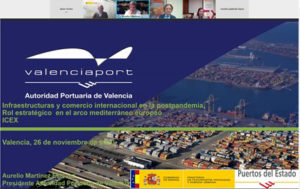
According to estimates of container traffic growth, when the new North Terminal is operational, the Port of Valencia will be managing 7.5 million containers.
The President of the Port Authority of Valencia points out that “international trade will continue to grow in the coming years. To continue being a strategic hub we need new terminals”.
He says that the new infrastructure in Valenciaport “will be efficient, will generate employment, will support the production system and will be respectful of the environment”.
Aurelio Martínez and Vicente Pallardó participated in the webinar “Infrastructures and international trade in the post-pandemic era: a strategic role in the European Mediterranean area” organised by ICEX.
The President of the Port Authority of Valencia (PAV), Aurelio Martínez, has affirmed that “according to estimates of growth in container traffic in 2030 the Port of Valencia will have reached its maximum capacity of 7.5 million containers. When the new north terminal is operational, we will be at the maximum of our occupation, so if we want to continue being a strategic hub port in the Mediterranean we need to strengthen the infrastructures to take on the growth of international trade and facilitate the export and import activity of our companies”.
Martínez participated in the webinar “Infrastructures and international trade in the post-pandemic period: a strategic role in the European Mediterranean arc” organized by ICEX Spain Export and Investment. During his speech, he explained to businesspeople and public and private institutions the main infrastructure projects in Valenciaport to strengthen its position as a mixed port – combining export/import and transhipment – and thus favour the economic and commercial activity of the Valencian Community and Spain.
Post-covid container traffic
The President of the PAV said that “in the last 50 years we have suffered four major crises that have affected maritime traffic. We have come out of all of them, just as we are going to come out of this one, with its adjustments and changes that will affect the economy as a whole. As after the previous crises, maritime traffic will continue to grow in the future, and therefore we must be prepared to respond to the import/export activity of companies”.
Thus, according to the Drewry index, container traffic worldwide will fall by 3.3% this year, while for the coming years it forecasts sustained growth of between 6.6 and 4.1%. In the case of Valenciaport, an average growth of 3% is estimated for the next few years, which means that 10 million containers will be managed in 2040.
“This situation highlights the need for a new northern terminal in Valencia, an extension that was started in 2000 and which has already completed the works on the breakwaters”, said Aurelio Martínez. The President of the PAV went one step further and explained that, as this type of work takes many years to complete and is very complex, it is necessary to think about new terminals, which cannot be done in Valencia. “The future growth of Valenciaport goes through Sagunto”.
New terminals and other strategic projects
Regarding the design of the new terminals like the one projected by TIL, Martinez has stated that “they will be efficient, they will generate qualified employment, they will support the productive system, they will be respectful with the environment, with a firm commitment to the railway. In short, they will make growth compatible with sustainability”.
During his speech, the President of the PAV also reviewed other strategic projects of the Port of Valencia such as the railway connections, the Logistics Activities Zone (ZAL), the new Public Passenger Terminal or the Technological Innovation programmes. Thus, he highlighted Valenciaport’s commitment to “intermodality and railway corridors both in the Port of Valencia and in Sagunto, which translates into contributions from the PAV of 88.6 million euros for projects such as the improvements to the Zaragoza-Teruel-València line, the railway access to the Port of Sagunto or the improvement of the intermodal terminal at La Fuente de San Luis”.
In the webinar organized by ICEX, Vicente Pallardó, an analyst of the economic situation of the Institute of International Economy (IEI), also spoke. He emphasized the “opportunity that Spain has with the European funds for the Covid-19 recovery to invest in an intelligent way to reorient the Spanish economy in a more productive way”.

